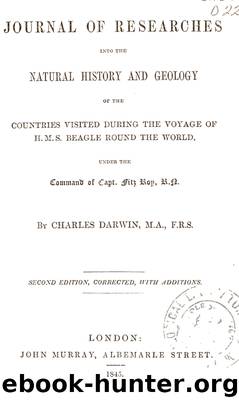Journal of Researches by Charles Darwin

Author:Charles Darwin [Darwin, Charles]
Language: eng
Format: epub
Publisher: J. Murray, London
Published: 1845-03-26T16:00:00+00:00
One day I rode up the valley to the farthest inhabited spot. Shortly above that point, the Cachapual divides into two deep tremendous ravines, which penetrate directly into the great range. I scrambled up a peaked mountain, probably more than six thousand feet high. Here, as indeed everywhere else, scenes of the highest interest presented themselves. It was by one of these ravines, that Pincheira entered Chile and ravaged the neighbouring country. This is the same man whose attack on an estancia at the Rio Negro I have described. He was a renegade half-cast Spaniard, who collected a great body of Indians together and established himself by a stream in the Pampas, which place none of the forces sent after him could ever discover. From this point he used to sally forth, and crossing the Cordillera by passes hitherto unattempted, he ravaged the farm-houses and drove the cattle to his secret rendezvous. Pincheira was a capital horseman, and he made all around him equally good, for he invariably shot any one who hesitated to follow him. It was against this man, and other wandering Indian tribes, that Rosas waged the war of extermination.
September 13th.—We left the baths of Cauquenes, and rejoining the main road slept at the Rio Claro. From this place we rode to the town of S. Fernando. Before arriving there, the last land-locked basin had expanded into a great plain, which extended so far to the south, that the snowy summits of the more distant Andes were seen as if above the horizon of the sea. S. Fernando is forty leagues from Santiago; and it was my farthest point southward; for we here turned at right angles towards the coast. We slept at the gold-mines of Yaquil, which are worked by Mr. Nixon, an American gentleman, to whose kindness I was much indebted during the four days I stayed at his house. The next morning we rode to the mines, which are situated at the distance of some leagues, near the summit of a lofty hill. On the way we had a glimpse of the lake Tagua-tagua, celebrated for its floating islands, which have been described by M. Gay.* They are composed of the stalks of various dead plants intertwined together, and on the surface of which other living ones take root. Their form is generally circular, and their thickness from four to six feet, of which the greater part is immersed in the water. As the wind blows, they pass from one side of the lake to the other, and often carry cattle and horses as passengers.
*
Annales des Sciences Naturelles, March, 1833. M. Gay, a zealous and able naturalist, was then occupied in studying every branch of natural history throughout the kingdom of Chile.
Download
This site does not store any files on its server. We only index and link to content provided by other sites. Please contact the content providers to delete copyright contents if any and email us, we'll remove relevant links or contents immediately.
| Cell Biology | Developmental Biology |
| Entomology | Marine Biology |
| Microbiology | Molecular Biology |
| Biostatistics |
Sapiens: A Brief History of Humankind by Yuval Noah Harari(14244)
The Tidewater Tales by John Barth(12608)
Mastermind: How to Think Like Sherlock Holmes by Maria Konnikova(7221)
Do No Harm Stories of Life, Death and Brain Surgery by Henry Marsh(6887)
The Thirst by Nesbo Jo(6826)
Why We Sleep: Unlocking the Power of Sleep and Dreams by Matthew Walker(6618)
Life 3.0: Being Human in the Age of Artificial Intelligence by Tegmark Max(5474)
Sapiens by Yuval Noah Harari(5293)
The Longevity Diet by Valter Longo(5017)
The Body: A Guide for Occupants by Bill Bryson(4973)
The Rules Do Not Apply by Ariel Levy(4842)
The Immortal Life of Henrietta Lacks by Rebecca Skloot(4523)
Animal Frequency by Melissa Alvarez(4394)
Why We Sleep by Matthew Walker(4358)
The Hacking of the American Mind by Robert H. Lustig(4318)
Yoga Anatomy by Kaminoff Leslie(4303)
All Creatures Great and Small by James Herriot(4228)
Double Down (Diary of a Wimpy Kid Book 11) by Jeff Kinney(4204)
Barron's AP Biology by Goldberg M.S. Deborah T(4095)
